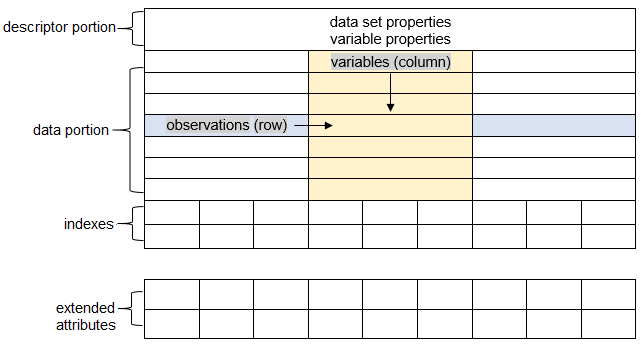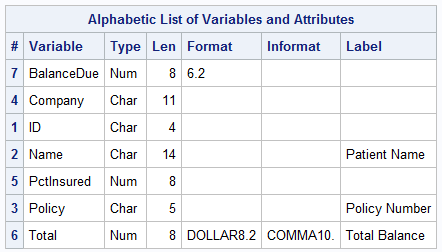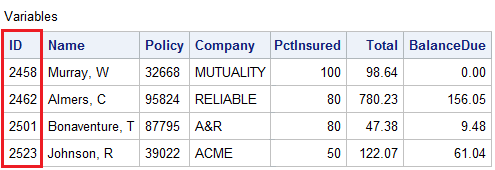SAS Data Sets
Overview of Data Sets
A SAS data
set is a file that consists of two parts: a descriptor
portion and a data portion. Sometimes a SAS data set also points to
one or more indexes, which enable SAS to locate rows in the data set
more efficiently. (The data sets that are shown in this chapter do
not contain indexes.) Extended attributes are user-defined attributes
that further define a SAS data set.
Figure 2.6 Parts of a SAS Data Set

Descriptor Portion
The descriptor portion of a SAS data
set contains information about the data set, including the following:
-
the name of the data set
-
the date and time that the data set was created
-
the number of observations
-
the number of variables
The table below lists
part of the descriptor portion of the data set Cert.Insure, which
contains insurance information for patients who are admitted to a
wellness clinic.
|
Data Set Name:
|
CERT.INSURE
|
|
Member Type:
|
DATA
|
|
Engine:
|
V9
|
|
Created:
|
07/03/2018 10:53:05
|
|
Observations:
|
21
|
|
Variables:
|
7
|
|
Indexes:
|
0
|
|
Observation Length:
|
64
|
SAS Variable Attributes
The descriptor portion
of a SAS data set contains information about the properties of each
variable in the data set. The properties information includes the
variable's name, type, length, format, informat, and label.
When you write SAS programs,
it is important to understand the attributes of the variables that
you use. For example, you might need to combine SAS data sets that
contain same-named variables. In this case, the variables must be
the same type (character or numeric). If the same-named variables
are both character variables, you still need to check that the variable
lengths are the same. Otherwise, some values might be truncated.
The following table
uses Cert.Insure data and the VALIDVARNAME=ANY system option. The
SAS variable has several attributes that are listed here:
|
Variable Attribute
|
Definition
|
Example
|
Possible Values
|
|---|---|---|---|
|
Name
|
identifies a variable.
A variable name must conform to SAS naming rules.
See Rules for SAS Names for SAS names
rules.
|
Policy
Total
Name
|
Any valid SAS name.
|
|
Type
|
identifies a variable
as numeric or character. Character variables can contain any values.
Numeric variables can contain only numeric values (the numerals 0
through 9, +, -, ., and E for scientific notation).
|
Char
Num
Char
|
Numeric and character
|
|
Length
|
refers to the number
of bytes used to store each of the variable's values in a SAS
data set. Character variables can be up to 32,767 bytes long. All
numeric variables have a default length of 8 bytes. Numeric values
are stored as floating-point numbers in 8 bytes of storage.
|
5
8
14
|
2 to 8 bytes
1 to 32,767 bytes for
character
|
|
Format
|
affects how data values
are written. Formats do not change the stored value in any way; they
merely control how that value is displayed. SAS offers a variety of
character, numeric, and date and time formats.
|
$98.64
|
Any SAS format
If no format is specified,
the default format is
BEST12. for a
numeric variable, and $w. for a character
variable.
|
|
Informat
|
reads data values in
certain forms into standard SAS values. Informats determine how data
values are read into a SAS data set. You must use informats to read
numeric values that contain letters or other special characters.
|
99
|
Any SAS informat
The default informat
for numeric is
w.d and for character
is $w. |
|
Label
|
refers to a descriptive
label up to 256 characters long. A variable label, which can be printed
by some SAS procedures, is useful in report writing.
|
Policy Number
Total Balance
Patient Name
|
Up to 256 characters
|
The following output
is the descriptor portion of Cert.Insure.
Output 2.2 Descriptor Portion of Cert.Insure

Data Portion
Data Portion Overview
The data portion of a SAS data set
is a collection of data values that are arranged in a rectangular
table. In the example below, the company
MUTUALITY is
a data value, Policy 32668 is a data
value, and so on.
Figure 2.7 Parts of a SAS Data Set: Data Portion

Observations (Rows)
Observations (also
called rows) in the data set are collections of data values that usually
relate to a single object. The values
2458, Murray
W, 32668, MUTALITY, 100, 98.64,
and 0.00 are comprised in a single
observation in the data set shown below.
Figure 2.8 Parts of a SAS Data Set: Observations

This data set has 21
observations, each containing information about an individual. To view the full
descriptor portion of this data set, see Descriptor Portion of Attributes in a SAS Data Set . A SAS data
set can store any number of observations.
Variables (Columns)
Variables (also called columns)
in the data set are collections of values that describe a particular
characteristic. The values
2458, 2462, 2501,
and 2523 are comprised in the variable
ID in the data set shown below.
Figure 2.9 Parts of a SAS Data Set: Variables

This data set contains
seven variables: ID, Name, Policy, Company, PctInsured, Total, and
BalanceDue. A SAS data set can store thousands of variables.
Missing Values
Every variable and observation in a
SAS data set must have a value. If a data value is unknown for a particular
observation, a missing value is recorded in the SAS data set. A period
( . ) is the default value for a missing numeric value, and a blank
space is the default value for a missing character value.
Figure 2.10 Parts of a SAS Data Set: Missing Data Values

SAS Indexes
An index is a separate
file that you can create for a SAS data file in order to provide direct
access to a specific observation. The index file has the same name
as its data file and a member type of INDEX. Indexes can provide faster
access to specific observations, particularly when you have a large
data set. The purpose of SAS indexes is to optimize WHERE expressions
and to facilitate BY-group processing. For more information,
see Specifying WHERE Expressions and see Group Processing Using the BY Statement.
Extended Attributes
Extended attributes
are user-defined metadata that is defined for a data set or for a
variable (column). Extended attributes are represented as name-value
pairs.
Tip
You can use PROC CONTENTS
to display data set and variable extended attributes.
Last updated: August 23, 2018
..................Content has been hidden....................
You can't read the all page of ebook, please click here login for view all page.
